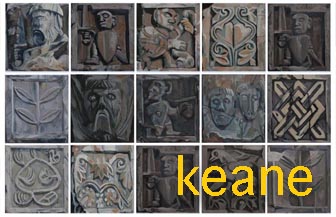Ten years ago, Dutch researcher and author Selma Sevenhuijsen visited Barga, drawn by the legacy of Matilda di Canossa. Her journey through Tuscany followed the trail of this powerful medieval countess, whose presence, she believed, still echoes in the region’s art and architecture.
In her final book on the subject, Queen of the Vatican, Selma proposed an intriguing theory: that the carved faces near the pulpit in Barga’s Duomo may well be those of Matilda, her mother Beatrice, and her father Boniface.
Matilda, the formidable Countess of Tuscany (1046–1115), inherited her father Boniface’s vast holdings and became one of the most influential secular supporters of the reformist papacy. After Boniface’s death, Beatrice married her cousin Godfrey, Duke of Upper Lorraine. Matilda later wed his son, also named Godfrey. By 1076, following the deaths of both her husband and mother, Matilda ruled Tuscany and Lorraine in her own right—governing a territory that included Reggio, Modena, Mantua, Brescia, Verona, Ferrara, and more.
Her prominence drew the attention of chroniclers and poets alike. Ekkehard described her as “the wealthiest, most famous woman of our times,” while Hugh of Flavigny praised her as a “virago”— a woman of such strength and virtue that she rivalled men in courage and leadership. Bardone, in his Life of Anselm of Lucca, called her “the single and only one who remains in the faith, with zeal for God and obedient to Pope Gregory.”
Selma Sevenhuijsen (1948–2024) studied political and social sciences in Amsterdam and became Professor of Women’s Studies and Ethics of Care at Utrecht University in 1989. From 2005 onwards, she worked independently as a researcher, writer, and spiritual guide, leading cultural and spiritual journeys through Italy and exploring ancient symbols and paths of inner development—often through the metaphor of the labyrinth.
Her work often connected mythology, spirituality, and history. In 2012, inside St Peter’s Basilica, she was struck by the image of a two-tailed mermaid—an ancient symbol of the divine feminine carved high on the tomb of Countess Matilda, a funerary monument sculpted by Gian Lorenzo Bernini. This discovery deepened her fascination and prompted a new journey across Italy to uncover the traces Matilda left behind.
Among her published works are:
2008 – De glimlach van de sirene. Reis door het Etruskisch labyrint op zoek naar de godin (The Smile of the Siren: A Journey through the Etruscan Labyrinth in Search of the Goddess)
2015 – Queen of the Vatican: Journey in the Footsteps of Matilda of Canossa
Selma’s work continues to inspire those drawn to the intersections of history, myth, and the sacred feminine. Her time in Barga was a small but significant part of her larger quest—to bring to light the stories of powerful women from the shadows of history.
Dieci anni fa, la ricercatrice e autrice olandese Selma Sevenhuijsen visitò Barga, attratta dall’eredità lasciata da Matilde di Canossa. Il suo viaggio attraverso la Toscana seguiva le tracce di questa potente contessa medievale, la cui presenza – secondo Selma – riecheggia ancora oggi nell’arte e nell’architettura della regione.
Nel suo ultimo libro sull’argomento, Regina del Vaticano, Selma avanzò un’ipotesi affascinante: che i volti scolpiti vicino al pulpito nel Duomo di Barga possano essere proprio quelli di Matilde, di sua madre Beatrice e di suo padre Bonifacio.
Matilde, la formidabile Contessa di Toscana (1046–1115), ereditò l’immenso patrimonio del padre Bonifacio e divenne una delle più influenti sostenitrici laiche del papato riformatore. Dopo la morte di Bonifacio, sua madre Beatrice sposò il cugino, Goffredo duca dell’Alta Lorena, mentre Matilde andò in sposa al figlio di Goffredo, anch’egli di nome Goffredo. Nel 1076, dopo la morte del marito e della madre, Matilde governò da sola sia la Toscana che la Lorena, amministrando territori che comprendevano Reggio, Modena, Mantova, Brescia, Verona, Ferrara e molti altri.
La sua figura attirò l’attenzione di cronisti e poeti contemporanei. Ekkehard la descrisse come “la donna più ricca, famosa e virtuosa del nostro tempo”, mentre Ugo di Flavigny la definì “virago” – una donna che superava persino gli uomini per virtù e coraggio. Bardone, nella sua Vita di Anselmo di Lucca, la chiamò “l’unica rimasta fedele, con zelo per Dio e obbediente a papa Gregorio, il duca e contessa Matilde”.
Selma Sevenhuijsen (1948–2024) studiò scienze politiche e sociali ad Amsterdam, diventando nel 1989 Professoressa di Studi Femminili ed Etica della Cura all’Università di Utrecht. Dal 2005 in poi lavorò in modo indipendente come ricercatrice, scrittrice e guida spirituale, conducendo viaggi culturali e spirituali attraverso l’Italia e utilizzando il simbolo del labirinto come percorso di sviluppo interiore.
Il suo lavoro univa spesso mitologia, spiritualità e storia. Nel 2012, all’interno della Basilica di San Pietro, fu colpita dall’immagine di una sirena bicaudata – un antico simbolo del femminile sacro – scolpita in alto sul monumento funebre di Matilde di Canossa, realizzato da Gian Lorenzo Bernini. Questa scoperta approfondì ulteriormente il suo interesse e diede il via a un nuovo viaggio attraverso l’Italia per scoprire le tracce lasciate da Matilde.
Tra le sue opere pubblicate:
2008 – De glimlach van de sirene. Reis door het Etruskisch labyrint op zoek naar de godin (Il sorriso della sirena: Viaggio attraverso il labirinto etrusco in cerca della dea)
2015 – Queen of the Vatican: Journey in the Footsteps of Matilda of Canossa (Regina del Vaticano: Viaggio sulle orme di Matilde di Canossa)
Il lavoro di Selma continua a ispirare coloro che sono attratti dall’intersezione tra storia, mito e femminile sacro. Il suo soggiorno a Barga fu una piccola ma significativa tappa di una ricerca più ampia: portare alla luce le storie delle donne potenti rimaste troppo a lungo nell’ombra della storia.




